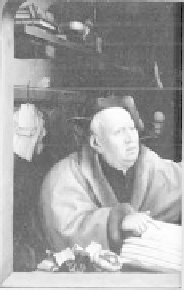Travel Reference
In-Depth Information
in their last bit of fun. Meanwhile,
some wicked souls are being punished,
victims either of their own stupidity or
of genetically engineered demons. The
good are sent to the left panel to frolic
in the innocence of paradise, while the
rest are damned to hell (right panel) to
be tortured under a burning sky. Bosch
paints the scenes with a high horizon
line, mak ing it seem that the chaos
extends forever.
The bizarre work of Bosch (who, by
the way, was not from Bruges) is open to many interpretations,
but some see it as a warning for the turbulent times. He painted
during the dawn of a new age. Secular ideas and materialism
were encroaching, and the pious and serene medieval world was
shattering into chaos.
• At the entrance to Room 4 is...
Jan Provoost (c. 1465-1529)—
Death and the Miser
A Bruges businessman in his office strikes a deal with Death. The
grinning skeleton lays coins on the table, and in return, the man—
looking unhealthy and with fear in his eyes—reaches across the
divide in the panels to
give Death a promis-
sory note, then marks
the transaction in his
ledger book. He's trad-
ing away a few years of
his life for a little more
money. The worried
man on the right (the
artist 's self-portrait)
says, “Don't do it.”
Jan Provoost (also
k no w n a s P r o v o s t)
worked for businessmen like this. He knew their offices, full of
moneybags, paperwork, and books. Bruges' materialistic capital-
ism was at odds with Christian poverty, and society was divided
over whether to praise or condemn it. Ironically, this painting's flip
side is a religious work bought and paid for by...rich merchants.
Petrus Christus (c. 1420-c. 1475)—
Annunciation and
Nativity
(1452)
Italian art was soon all the rage. Ships from Genoa and Venice
would unload Renaissance paintings, wowing the Northerners






















